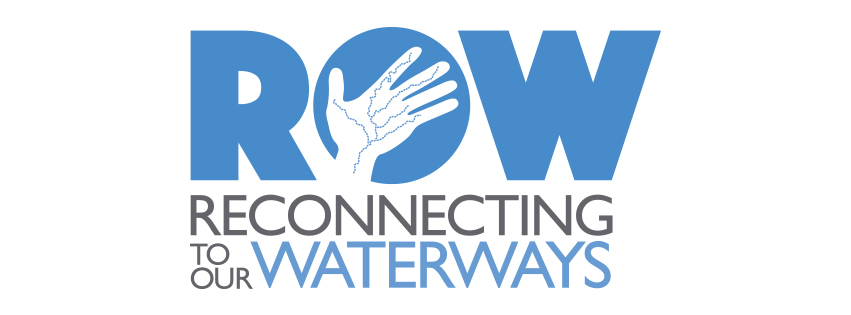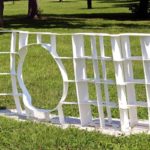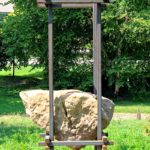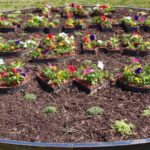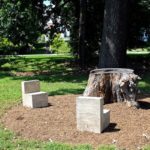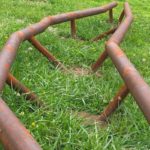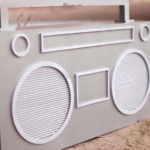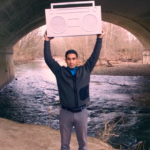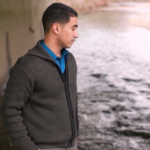Art Along Our Waterways
Turning the great outdoors into a destination for the general public can inspire community involvement and a connection with nature. Reconnecting to Our Waterways and partner organizations, like the DaVinci Pursuit and the Herron School of Art and Design at IUPUI, work together to stimulate neighborhoods through the use of beautiful and very unique outdoor art.
This art not only intrigues the public, but also draws attention to the nearby waterways while creating educational opportunities.
Rest Stops on Pogue’s Run Trail – Outdoor Art Inspires Curiosity
There are several outdoor art pieces that were created in order to inspire the general public and instill a sense of curiosity. One of them is the Pogue’s Run Rest Stop project: three rest stops – one in the Cottage Home neighborhood, one in Spades Park and one at the Paramount School of Excellence – that are intended to draw attention to the waterways and work in conjunction with the future Pogue’s Run Trail. Three different level of artists built the pieces in an effort to involve a great number of community members: professional artists, student artists from the Herron School of Art and Design at IUPUI, and high school student artists from Arsenal Tech.
One of the professional artists and director of the project, Eric Norduglen, is a Near Eastside resident, ROW Pogue’s Run committee member and a faculty member in the sculpture department at Herron’s. Norduglen tries to stay active in promoting public art, both in the community and in the classroom.
“We have an interest in seeing our students work with the community and exploring what happens to art when it’s made available to the public or people in the neighborhoods on a regular basis,” Norduglen said. “Art has a way of adding some sort of new idea or new information to a familiar landscape. Art can begin to change that landscape and draw our attention to different ideas.”
Another professional artist that worked on the pieces is Greg Hull. Hull created three related works, one for each of the Rest Stop locations, called Stone Lanterns. These pieces aim to explore the relationship between visitors and the waterways as a “poetic intersection,” according to Hull, creating a place for contemplation and meditation. Heavy river rock floats inside the steel frameworks of the Stone Lanterns, creating a parallel between the rocks’ previous location – naturally floating within the stream of a river – and their new location – controlled in a steel frame. This feeling of control is partially what inspired Hull when creating his piece.
While he searched for an active way to bring people closer to the waterway, or bring the waterways closer to the people, Hull was also dealing with the loss of a family member.
“I believe that loss introduced a shift in the work that culminated in my interest in discussing the human desire to control the forces of nature,” he said.
- Spades Park Rest Stop “Grid Currents”
- Paramount Rest Stop “Blocks”
- Spades Park Rest Stop “Stone Lanturn”
- Paramount Rest Stop “Floral Excerpts”
- Spades Park Rest Stop “History of Magic”
- Cottage Home Rest Stop “Ebb and Flow”
- Spades Park Rest Stop “Watermark ”
- Cottage Home Rest Stop “Bridges”
The Stone Lanterns are especially unique because they invite visitors to listen to the sounds of the waterways. Using a smart phone, visitors can scan QR codes at the Lanterns to access recordings of Pogue’s Run taken on the day the pieces were installed.
The third expert artist who helped work on these pieces is Emily Stergar. Stergar assisted both Nordgulen and Hull in aiding the students through the development process of the pieces. Stergar worked on the piece entitled Dredge at the Paramount School of Excellence, as well as Reroute at the Cottage Home neighborhood. Dredge is made from dirt that was actually pulled from the White River and cast into blocks that sit at the top of a hill. The blocks cascade down the hill, in an effort to make them look as though they’re making their way back to the creek, according to Stergar. The different pieces have different ratios of dredge to create this feeling of going to the creek. The Reroute piece is similar, except one of the blocks is made from concrete.
“At this location, I kept thinking about how this is the closest Rest Stop to where the Creek is rerouted underground,” Stergar said. “I wanted two solid blocks of dirt that met up with a third that had a hole in its center, symbolizing the path the water would now take – from on top of a surface to going through it.”
The Pogue’s Run waterway and site of the future Pogue’s Run Trail was purposely chosen for these pieces in an attempt to link the neighborhoods together.
“We hope that as the Trail continues to develop, and as these types of things continue to happen art-wise, that it’s a way to unify the several neighborhoods together,” Norduglen said. “Our hope is that we can start to think of ourselves as an even larger community.”
Along with creating awareness about the waterways and bringing the community together, pieces like the Rest Stops are intended to instill a sense of curiosity within the community. According to Hull, engaged public art can add to an area’s identity and even has the ability to make a place turn into a destination for the entire neighborhood to rally behind.
Flyer Fish Mural and FLOW – Outdoor Art Tells a Story
Across from Elder W Diggs School 42 on W. 25th St. along the Canal is the Flyer Fish mural. Designed by young local artist Jamahl Crouch, the mural shows a detailed depiction of a fish breaking the barrier of the water and ascending into an endless sky.
Crouch became involved with ROW through the Learning Tree Doors project when he worked on a live painting exhibition. ROW funded Jamahl’s mural designs and engaged students from School 42 by having them paint it.
“I was always amazed with the concept of a flying fish,” Crouch said. “ I imagined a fish attempting to fly and the impossibility of it all. Despite all odds, there are fish that fly, making the impossible, possible.”
Crouch describes the mural as a metaphor for life: through positive thinking and commitment, someone could be like the flying fish. Someone could break through the water (or their own specific barrier) and achieve the impossible. This type of art is important to proudly feature, as it creates dialogue grounded in considerate thought.
Art is one of the highest forms of intellectual expression, according to Crouch, and when art is outside on display, it’s something the community can truly be proud of. Art signals an area of intelligence, an area full of people worth listening to.
“The Flying Fish mural has a story, a story that relates to the good people who have been here for many years,” Crouch said. “So when people see the work, it urged them to tell me their story and educate me about where I live. It started conversation.”
Starting conversations is just one important goal that ROW has for the community, as this can often be the first step in facilitating change or spreading awareness. The mural is near the Canal, drawing people to it as a point of conversation and a place of interest.
Another piece that succeeds in telling a story through art is FLOW, a temporary art piece designed by Wil Marquez located in one of the daVinci ArtPorts on the south side of the Barth Avenue Bridge on South Pleasant Run Parkway. The daVinci ArtPorts are an initiative through the daVinci Pursuit, an organization with a mission to connect art, science and community, according to CEO and founder Mark Kesling. These daVinci ArtPorts create new ways for pop-up art to occur, creating a dynamic, visually appealing landscape for artists. FLOW will move from location to location using the daVinci ArtPorts for the next five years, at which point it will be retired.
The pop-up FLOW piece uses musical forms to communicate the surrounding neighborhood’s memories and stories about local waterways. The piece uses three songs or “flows” creatively composed by AJ Vinson, NSB and Phil Nap to inspire the city, promote the environment and showcase a musical experience for everyone.
Listen to one of the songs here
Using basic computer programming, FLOW can sense when people pass by, triggering the “flows” to start playing. As FLOW surrounds people with its streams of music, they are invited to think about the way in which the water can impact a local community, according to Kesling.
“As more and more people experience FLOW, the hope is that conversations will trigger deeper connections to local waterways, and thereby impact the ways in which FLOW is experienced in future visits,” Kesling said. “In this way, the culture of water and local communities is always flowing.”
Similar to the Flying Fish mural, FLOW creates conversation. It exists to deliver a powerful set of messages to each community in an entertaining, imaginative way.
Ka-Bike-O-Scope and Silver Fall II – Outdoor art engages the community
Interactive art, like the Ka-bike-O-Scope at Pleasant Run Trail and Barth Avenue and Silver Fall II at Delaware Street and Fall Creek Parkway, helps to directly involve the community with the arts, sciences and the waterways.
The Ka-Bike-O-Scope is yet another creative initiative through the daVinci Pursuit in conjunction with ROW. Created by artist Quincy Owens and physicist Luke Crawley, the piece was born from a community-wide design competition with intent to bring science into the neighborhoods. The inspiration for the Ka-Bike-O-Scope was to merge both the artists’ and the neighborhood’s desires together. The neighborhood was looking for something that brought light into the community. The daVinci Pursuit wanted the piece to be interactive; something you might find in the Children’s Museum, according to Kesling.
“What’s great is we can take the ideas of what we think they’d like to accomplish, and then we can give them something they may have never even thought of,” Kesling said. “In this case, that’s the Ka-Bike-O-Scope, and it’s really a beautiful merger of the two groups.”
The piece is two-fold, with two large kaleidoscopic kinetic sculptures and two stationary bikes right next to each other. As people pedal the bikes, wheels 18 feet up in the air held in a canopy structure begin to spin, creating a beautiful, colorful pattern from the acrylics inside the wheels. The lights can also be seen at night through LED lighting. The Ka-Bike-O-Scope is highly interactive, with a bike that beckons people to come by and try it out for themselves.
This style of art engages our communities and inspires outdoor activity, another important goal for ROW. The purpose of the Ka-Bike-O-Scope is not only to connect people to their natural surroundings, but also to make them curious about other outdoor activities.
The brand new Silver Fall II is another piece with a purpose: invite its viewers to interact with it. The sculpture is a part of Destination Fall Creek, a neighborhood initiative addressing several improvements, including better access to nature and the Fall Creek waterfront. ROW has helped fund a part of this development.
Silver Fall II was installed in July of this year. The piece is a 1,200-pound sculpture consisted of 10’ tall, curved aluminum panels adorned with falling maple leaves. Artist Scott Westphal created the piece in an effort to make a gateway sculpture celebrating the revitalization of the Mapleton-Fall Creek neighborhood.
“The meandering shape of the two monolithic counterparts representing the neighboring creek and maple leaves blowing in the wind were intended to invite the viewer to interact with the sculpture,” Westphal said. “In the daytime, I like how the leaves are in shadow, and at night, lit from the inside, they seem to twinkle and dance.”
Outdoor art makes these areas a hot-spot, drawing people closer to the waterways and opening the door up to possibilities – possibilities for the public to consider how else they could connect with the community and waterway. In fact, just this past September, ROW hosted the Delaware Street Gateway Celebration. The celebration featured talks from our partners, food trucks and a night filled with music and dancing, engaging people with the outdoors and the Silver Fall II piece in an exciting way.
“Art has the ability to reveal new meaning or a more nuanced understanding of the work to visitors that reconsider it over an extended period of time,” artist Greg Hull said. “[Art] can encourage people to follow the waterway and to explore the next site and then the next.
“It encourages all of us to become explorers or engaged cultural tourists in the neighborhoods just beyond our own.”
